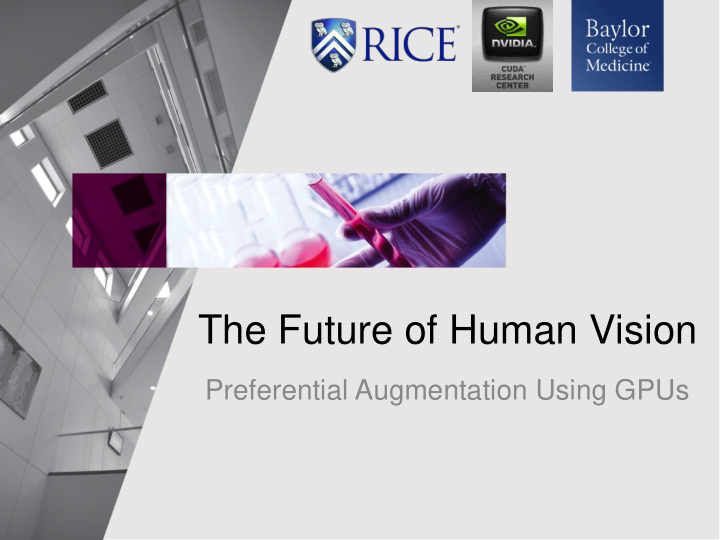



The Future of Human Vision Preferential Augmentation Using GPUs
Wikimedia Foundation
Nearsightedness Simulation
Diplopia Simulation
Early Stage Macular Degeneration Simulation
Protanopia Simulation
Current Situation • Traditional glasses limited (Snell’s Law) Patient.co.uk
The Idea • Broader class of transformations • Specific Cases – Colorblindness – Macular degeneration
Computer Mediated Vision Input (Camera, Computational Output to other sensors) processing screen
OpenGL ES Pipeline Vertex Generating Primitives; Fragment Testing, Shader Shader Rasterization Mixing Frame Buffer
Current Medium
Reality Hacker (Google Play)
Colorblindness • LMS (wavelength) color space • Daltonization
Colorblindness
Colorblindness precision mediump float; varying vec2 textureCoordinate; uniform sampler2D texture1; const vec2 gcoeff = vec2(-0.255, 1.255); const vec3 bcoeff = vec3(0.30333, -0.545, 1.2417); void main() { vec4 tex = texture2D( texture1, textureCoordinate ); float g2 = dot(tex.rg, gcoeff); float b2 = dot(tex.rgb, bcoeff); gl_FragColor = vec4(tex.r, g2, b2, tex.a); };
Colorblindness
Colorblindness
Colorblindness
Macular Degeneration • Patient specific distortions • Amsler grid diagnostics
Macular Degeneration
Customize your World
Customize your World
Customize your World
Customize your World
Customize your World
C 2 – Impossible Colors • Simple model for each eye • Retinal Rivalry – Neural experience in C 2 – Pseudo C 2 ~ GIFs – Perception variation – Alternative Correction
Performance • 30 FPS (Camera API) • CPU: 7% • RAM: 232 MB • GPU: 96% • 2.4 Hours Battery
Challenges • Real time imagery – Refresh Rate – Time delay • Proper stereoscopy • Field of view – Fisheye Lens
Future Directions • Medical studies – Usability of diagnostic tools – Vision improvement • Sensory expansion – UV/IR – Sound – Magnetic fields, other data sources
Acknowledgements • Dr. Erez Lieberman Aiden • Members of the Aiden Lab • Robert and Janice McNair Foundation
Thank You! Muhammad Saad Shamim Baylor College of Medicine Questions? One Baylor Plaza Comments? Houston, TX 77030 aidenlab.org linkedin.com/in/ muhammadsaadshamim
Recommend
More recommend